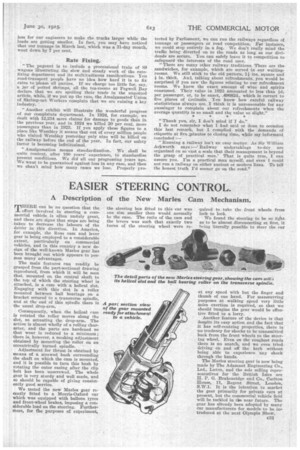EASIER STEERING CONTROL.
Page 15

If you've noticed an error in this article please click here to report it so we can fix it.
A Description of the New Marks Cam Mechanism.
mITERE can be no question that the
effort involved in steering a commercial vehicle is often unduly great, and there are signs that steps are being taken to decrease the labours of the driver in this direction. In America, for example, the Ross cam and lever gear is being employed to a considerable extent, particularly on commercial vehicles, and in this country a new design of the well-known Marks gear has been brought out which appears to possess many advantages.
The main features can readily be grasped from the part-sectional drawing reproduced, from which it will be seen that, mounted on the central shaft to the top of which the steering wheel is attached, is a cam with a helical slot. Engaging with this slot is a roller mounted between ball bearings on a bracket secured to a transverse spindle. and at the end of this spindle there is the usual drop-arm.
Consequently, when the helical ram is rotated the roller moves along the slot, so actuating the drop-arm. The action is almost wholly of a rolling character, and the parts are hardened so that wear is reduced to a minimum ; there is, however, a meshing adjustment obtained by mounting the roller on an eccentrically turned spindle.
Adjustment for thrust-is obtained by means of a screwed bush surrounding the shaft on which the cam is mounted, and it is possible to turn this bush by rotating the outer easing after the clip bolt has been unscrewed. The whole gear is very sturdy and well made, and so should be capable of giving consistently good service.
We tested the new Manes gear recently fitted to a Morris-Oxford car which was equipped with balloon tyres and front-Wheel brakes, imposing a considerable load on the steering. Furthermore, for the purposes of experiment, the steering box fitted to this ear was one size smaller than would normally be the case. The ratio of the cam and the levers was such that exactly two turns of the steering wheel were re quired to take the front wheels from lock to lock.
We found the steering to be so light as to be almost disconcerting at first, it being literally possible to steer the car at any speed with but the finger and thumb of one hand. For manceuvring purposes at walking speed very little more exertion is required, so that we should imagine the gear would be effective fitted to a lorry.
Another feature of the device is that despite its easy action and the fact that it has self-centring properties, there is no tendency for shocks to be transmitted back from the front wheels to the steering wheel. Even on the roughest roads there is no snatcl. aud we even tried driving on and off the kerb without being able to experience any shock through the hands.
The Merles steering gear is now being made by The Adamant Engineering Co., Ltd., Luton, and the sole selling representatives for the British Isles are H. P. G. Brakenridge and Co., Carlton House, 11, Regent Street, London, S.W.1. It is the intention to market the gear primarily for private cars at present, but the commercial vehicle field will be tackled in tie near future. The gear has already been adopted by many car manufacturers for models to be introduced at the next Olympia Show.






























